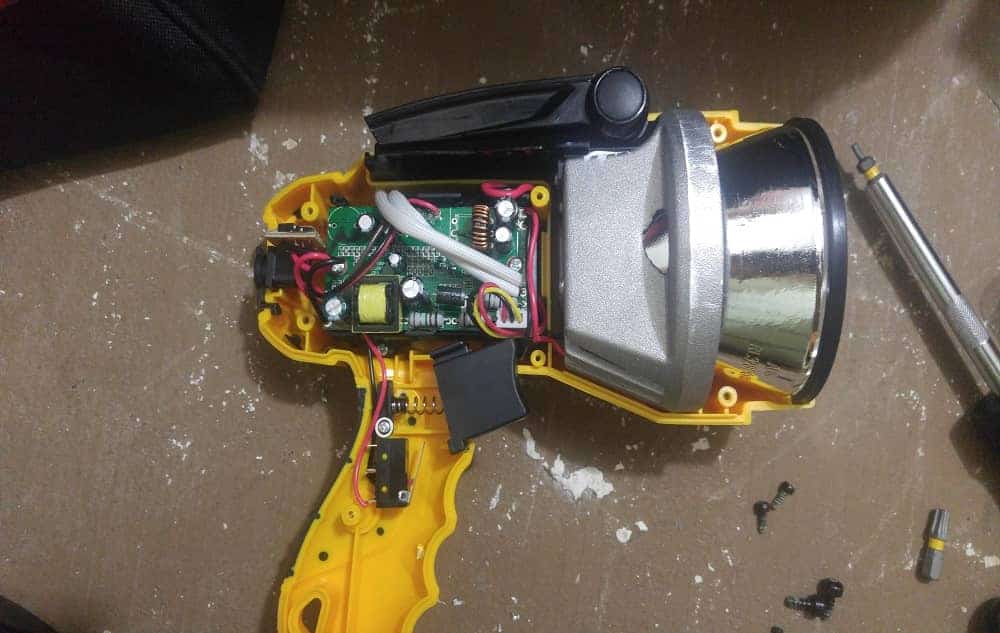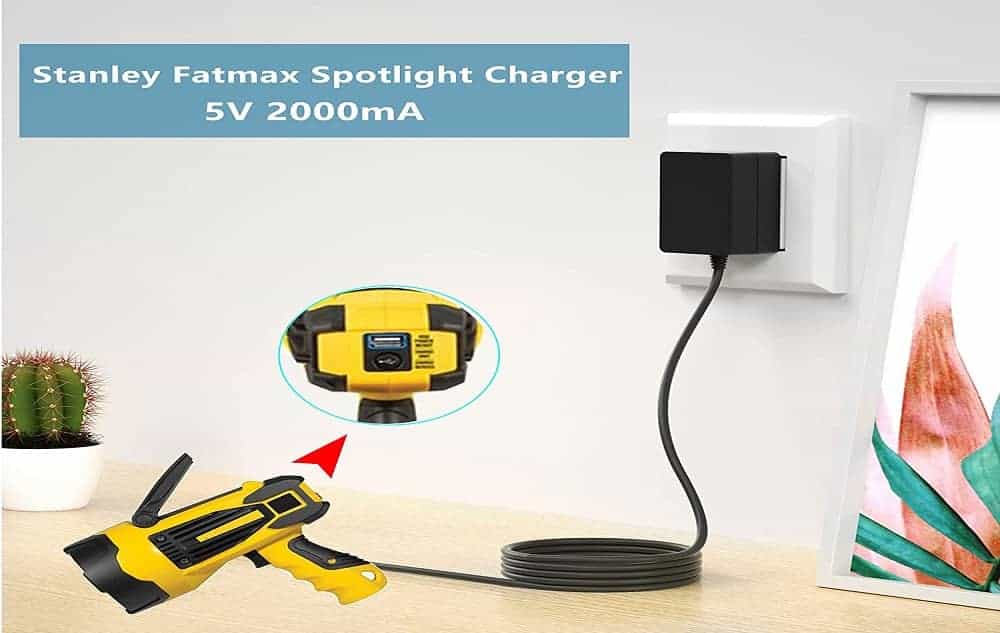When your large, powerful Fat Max rechargeable flashlight suddenly stopped working after years of consistent use. It disappoints because it had been a reliable waterproof tool that had cast a bright beam of light for a quarter mile or more, ideal for checking the creek level during storms or determining what was making that noise along the fence-line.
The front lens and bumper are unscrewed, and the internal components slide out in one piece. Three screws hold the plastic end in place. You can also remove all of the internal components when you remove the end cap. In the article below, we will discuss different troubleshooting methods of Stanley fatmax spotlight.
Table of Contents
How to fix a Stanley fatmax spotlight

First, you assume the rechargeable batteries have died, so you disassemble the device to see if you could replace them. I accidentally turned on the light while disassembling it. The sun was still shining brightly. Because the batteries were not the issue, I began my search for the root of the problem.
It wasn’t a long process. The magnetic reed switch had malfunctioned. To avoid making penetrations in the case, the Stanley designers used reed switches. The reed switched through the plastic case was triggered by magnets in the On/Off switch and the dimmer dial. It was a unique feature, and I thought it was well-designed.
Under the on/off or dimmer switch, there is no hole. Instead, the magnetic force is sensed directly through the plastic by the reed switch. Only the front and back of the case have openings, and when the flashlight assembles fully, they are both well sealed. Magnets are stored in the On/Off and dimmer switches, but neither penetrates the waterproof case.
The magnets in the On/Off and dimmer switches are strong enough to activate magnetic reed switches on their PCB directly above the switch. The broken on/off reed is in the lower center, and the two at the board’s upper edge are for the dimmer switch.
Both the intact and broken reed switches have rubber pads underneath them, whereas the broken one does not.
Steps for troubleshooting a non-charging Stanley fatmax spotlight

Several reasons can result in your spotlight not to charge. For instance, if your battery is dead, the charger is damaged, the spotlight hibernates after a long time before using it, among other reasons.
The failure of the Cyclops spotlight to charge is a common issue that a variety of factors can cause. As a result, resolving the issues improves the cyclops spotlight’s charging efficiency.
Step 1: Look over your Stanley fatmax spotlight plugin
Check to see if your Stanley fatmax spotlight plugin is in good working order or if it has damage. First, make sure the connector is connected ultimately to the plugin, and then turn on the light. When a plug is correctly connected but no light. The connector is damaged. Repair your plugin and connectors as needed, then reconnect to see if the light comes on. It is essential to replace your connector if it is severely damaged.
Step 2: Make sure your Stanley fatmax spotlight battery is in good working order
PCB is used in spotlight batteries. The PCB protects the battery from the total current that could damage the spotlight.
Step 3: Check your battery to see if it has gone into hibernation
When your battery isn’t charging, it could be because your spotlight is in hibernation mode, which means it hasn’t been used or charged in a long time, and when you try to charge it, no LED lights light up indicating that it isn’t charging. As a result, check your spotlight’s hibernation mode and see if you can wake it up.
Try turning on your spotlight’s battery to bring it out of hibernation mode, and a red light will appear. Allow 3 to 5 minutes for the red light to appear. Charge your spotlight while the battery is still in place and leave it to charge for several hours.
Step 4: Check your Stanley fatmax spotlight for a short circuit in the circuit breaker
Your circuit breaker has an automatic short circuit when you stop charging your Stanley fatmax spotlight for an extended period. If your circuit breaker trips while you’re using your spotlight or charging it, it’s likely that your spotlight has a short circuit. To solve the problem, make sure your circuit breaker is short-circuited and checked for resistance. To determine if there is a short circuit in your spotlight, use a multimeter.
Determine where the short circuit is in the spotlight. Remove the short circuit to see if that helps.
Step 5: Check to see if your spotlight charger is damaged
If your charger is damaged or blown out, your spotlight will not charge. Sift through your charger to see if the wiring is correct and if connected loosely to other components. To see if the spotlight will charge, tighten the loose cables and use the charger.
If it fails, purchase a new charger or try charging the spotlight with a different charger. If the sporting begins to charge, the problem is with the charger; however, if it fails, look for other causes for the spotlight not to charge.
Step 6: Check for dead spotlight batteries
Checking the battery in your spotlight is an essential step in determining the state of the battery. When you don’t use your battery for a few months, it starts to die slowly.
To begin, turn on your spotlight and wait for the charging time to expire. After that, connect a micro-USB charger to the battery charging port to see if your battery is in good working order. Your battery is in good condition if the red and green lights are on; however, your battery is dead, and you have to replace it if the lights are off.
Considerations when using your Stanley fatmax spotlight
Ensure that your battery does not discharge to 0%. Depletion can result in the battery dying. It is advisable to keep recharging your spotlight battery once you have received a low battery warning.
- Purchase spotlight batteries of high quality. Low-quality batteries get damaged or depleted faster than batteries of high quality.
- Check your spotlight frequently to identify any problems and try fixing them early enough. Frequent inspection of your spotlight prolongs the lifespan of your spotlight and improves its efficiency.
- Avoid using non- Stanley fatmax batteries because they damage your spotlight.
- Ensure you follow the manufacturer’s instructions anytime you want to troubleshoot problems affecting your battery.
Frequently asked questions
1. What are the brightest handheld spotlights?
People nowadays rely on LED flashlights in their smartphones, thanks to technological advancements. Other than that, people use EDC (Everyday Carry) lights to light up dark alleys during power outages. On the other hand, these lights have a limited capacity and cannot assist in larger areas.
On the other hand, a spotlight is a powerful lamp that casts a narrow beam of light in its path. Furthermore, this spotlight beam is simple to control, and you can point it in any direction without losing its power. EDC lights have a weaker and less intense beam than spotlights. Let’s take a look at the top five brightest handheld spotlights currently available.
Conclusion
Failure of your spotlight not charging can make you have difficulties in troubleshooting it. From the above information, you have known possible causes of your spotlight not charging and how you can fix the problems. The steps will help you get your spotlight charging again, and they are easy to understand and simple to apply.
Frequently check your spotlight and identify any problems affecting your spotlight, for example, a dead battery and a blown-out charger. Finally, follow the manufacturer’s instructions to avoid damaging your battery.
